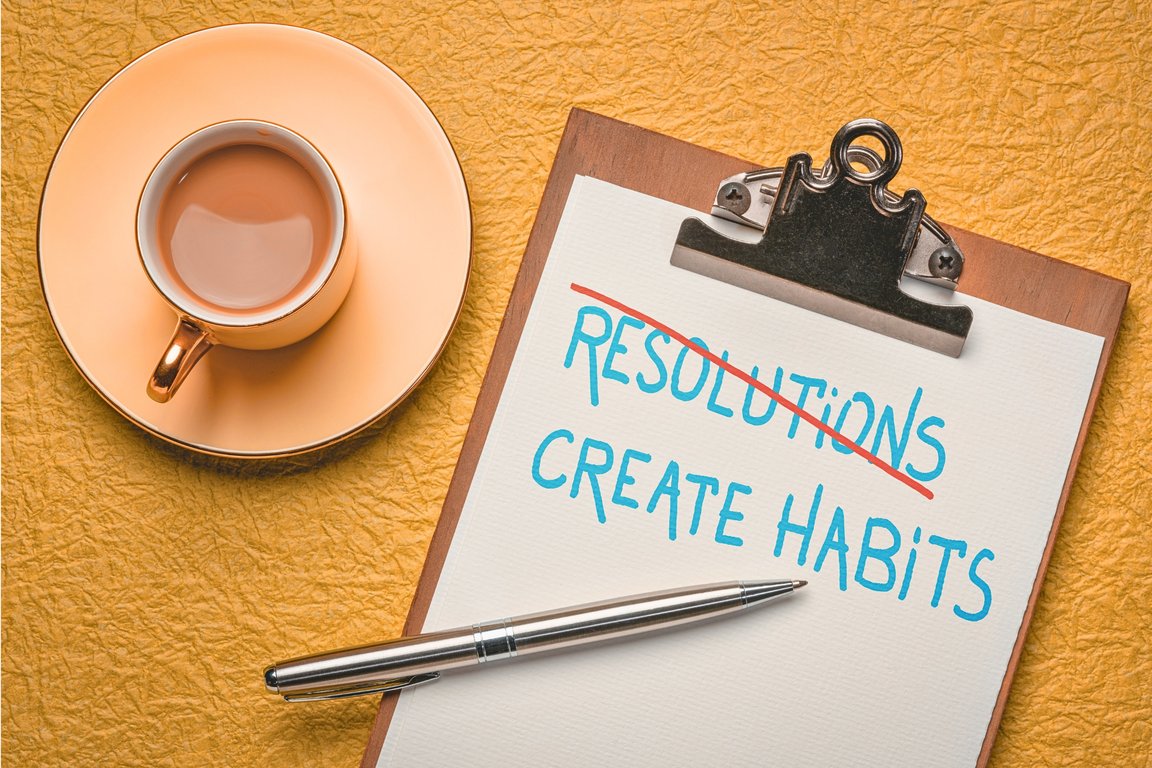You’ve likely been told that setting goals is the key to success. And it’s true - goals matter.
But what if your brain doesn’t actually crave goals? What if, biologically and behaviorally, it's habits that drive real, lasting change?
In this post, we’ll dive deep into the science behind how your brain processes goals vs. habits. We’ll look at why many goal-setting strategies fall short. And we’ll discover how to build habits that work with your brain, not against it.
Habits vs Goals
Why Your Brain Prefers Habits Over Goals
Ever felt like you’re fighting your own brain when trying to stick to something new? It’s not just you! There’s a fascinating neurological reason for it.
Goals, as great as they are for direction, demand conscious effort. Habits, on the other hand, are your brain’s ultimate autopilot mode.
From a brain perspective, habits are simply more efficient.
When you do something repeatedly in the same situation, a specific part of your brain called the basal ganglia takes over. Think of it as your brain’s super-efficient "routine manager." It creates a "habit loop" that runs with minimal thought.
Your prefrontal cortex is the part of your brain that makes decisions and sets goals. It’s powerful, but it’s also slow and uses a lot of energy. Your brain naturally tries to save energy. So, it prefers habits - those quick shortcuts it doesn’t have to think about.
That’s why you can brush your teeth, tie your shoes, or drive to work without really thinking.
Once a habit is formed, it bypasses the mental effort of decision-making. This also explains why bad habits, like mindlessly checking your phone, are so easy to fall into. Your brain just wants to be efficient, no matter the habit.
📚 Study highlight: It's not just a feeling! A 2006 Duke University study found that about 45% of our daily behaviors are not decisions - they’re habits. That’s nearly half of your day on autopilot!
→ Wood, Quinn & Kashy, 2002 – Habits in everyday life (JPSP)
Habits and Goals: One Needs Motivation, The Other Builds Momentum
When we set a goal - say, "exercise 3 times a week" - we often rely on willpower and motivation. These are supposed to bridge the gap between wanting to do something and actually doing it.
But motivation is a limited resource. It’s also unreliable.
Behavioral scientist BJ Fogg points out that relying on motivation leads to ups and downs.
Instead, we need systems that don’t depend on being motivated every single day.
→ Fogg Behavior Model – Stanford Behavior Design Lab
Think about New Year's resolutions. They often start with a huge burst of motivation. But when that motivation fades, so does the resolution.

🧠 Brain fact: Motivation lights up the ventral striatum, linked to anticipating rewards. But if the reward isn't quick or clear, motivation can drop fast.
→ Knutson et al., 2001 – Anticipation of monetary reward activates nucleus accumbens (J. Neurosci.)
Habits remove that instability. Once a behavior becomes automatic, you don’t need daily motivation. You just do it.
That’s why habit-based systems often win over goal-based plans.
When motivation dips - which it always will - habits keep you on track.
Each time you stick to a small habit, you’re not just checking a box. You’re telling your brain, "I can do this!".
These small wins add up, making the next step feel easier.
Why Goals Often Fail (Even SMART Ones)
Ever heard of the "intention-behavior gap"? It’s the scientific term for when we have good intentions (like setting goals) but don’t follow through.
Psychologist Peter Gollwitzer studied this a lot. He found that even when people mean to change, their behaviors often stay the same.
→ Gollwitzer & Sheeran, 2006 – Implementation intentions and goal achievement (Psychological Bulletin)
Here’s why this happens:
- Goals are too vague: "Eat healthier" or "be more productive" can feel overwhelming. What does "healthier" even mean right now? This lack of clarity creates friction.
- The payoff is delayed: Your brain loves immediate rewards. If you want to lose 10 pounds, the reward feels far off. It’s hard for your brain to link today's effort with a distant benefit.
- Life gets in the way: Without automatic routines, progress needs constant conscious effort. One missed day can easily derail everything. Imagine aiming to work out for an hour every morning. If your alarm fails, it’s easy to skip and then just stop.
Even SMART goals (Specific, Measurable, Achievable, Relevant, Time-bound) often fail. They need to be paired with habits that support them.
The Habit Loop: Cue – Routine – Reward
Charles Duhigg popularized the "habit loop" in The Power of Habit. It's based on research from MIT. The cycle works like this:
- Cue: A trigger that starts the behavior.
- Routine: The behavior itself.
- Reward: A benefit your brain craves.
Over time, your brain begins to expect the reward when the cue appears. This creates a strong feedback loop.
→ MIT research: Graybiel lab on habit loops (MIT News)
🧪 Example from neuroscience: In rat studies at MIT, researchers saw brain activity spike at the start (cue) and end (reward) of a habit. But not during the middle (routine). This proves the brain runs habits on autopilot once triggered.
This is why habit stacking is so effective.
You link new habits to things you already do. For example, "After I brush my teeth (existing cue), I will do 5 squats (new routine)." You’re plugging new routines into your brain’s existing reward circuits.
What Research Says About Habit Formation

A key study from University College London (2009) tracked how long it takes to form habits.
→ Lally et al., 2010 – How are habits formed? (European Journal of Social Psychology)
Findings:
- It took, on average, 66 days for a behavior to become automatic.
- Simpler habits (like drinking water) formed faster than complex ones. This shows that starting tiny isn't about laziness. It's about making it so easy your brain doesn't resist.
- Missing a day didn’t ruin progress. Consistency over time mattered more than perfection. This debunks the "21-day rule." Your brain needs regular, repeated actions, not just a short timeline.
Habits Shape Identity. Goals Chase Outcomes.
Author James Clear argues that the most powerful habits are identity-based:
- Outcome-based goal: "Run a marathon."
- Identity-based habit: "I'm a person who runs."
This shift is crucial because your brain loves consistency. When your actions match how you see yourself, they become easier to keep up.
🧠 Psychology insight: According to Cognitive Dissonance Theory, we try to match our self-image with our actions. So, repeated habits start to change how we see ourselves. This makes them last. Each time you act like the person you want to be, you strengthen that identity.
It’s a strong cycle: actions shape identity, and identity drives actions. This creates inner motivation beyond willpower.
→ Festinger, 1957 – A Theory of Cognitive Dissonance
Are Goals Still Useful?
Yes, absolutely! Goals give you clarity and direction. But they don’t deliver results alone.
Think of a goal as your destination. Habits are the vehicle that gets you there. One tells you where to go. The other makes the journey happen.
If you want lasting change, build habits that align with your goals. You need both. But habits are what make the goal real.
How to Build Habits That Last
Here’s a science-backed formula to build habits that stick:
- Start tiny: Begin with something so easy it feels silly to skip. Like one push-up or reading one sentence.
- Use cues: Link new habits to things you already do. "After I finish my morning coffee, I will write for two minutes."
- Celebrate: Reward yourself right away, even with a quick mental "yes!" or a fist pump. Your brain needs that quick win.
- Track visually: Use streak charts or apps. Your brain loves to see progress and keep a chain going.
- Do it daily: Frequency builds ease. Aim for consistency, not perfection. If you miss a day, just get back on track the next.
- Design your environment: Make it easy to do the good habit and hard to do the bad one. Want to drink more water? Keep a water bottle always visible.
Build Better Habits - Together
You don’t need more pressure. You need better systems. And you need people who understand the journey.
At Goal Watch, we help you bridge the gap between habits and goals. We do this with small, supportive communities that build accountability and momentum.
📅 Build a system. 🤝 Stay consistent. 🚀 Make it stick.
👉 Join your habit group today at goalwatch.net.





